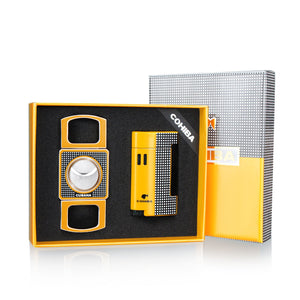Some key moments that make a cigar
Spanish explorer Christopher Columbus is generally credited with being the first to introduce tobacco to Europe. During his journey in 1492, three of his stewards, Rodrigo de Jerez, Hector Fuentes, and Luis de Torres, are said to have encountered tobacco for the first time when it was introduced to them by locals. These dried leaves give off a special aroma when lit. Columbus's sailors reported that the Taino people on the island of Cuba rolled up a dry leaf and lit it for smoking. This was the most primitive cigar. Since then, cigars have written a magnificent history. There are several very pivotal moments in the history of cigars that have made cigars what they are today.
In 1531, Spain began to grow tobacco leaves on the island of Santo Domingo.
In 1542, the Spanish established the first cigar factory in Cuba, and tobacco began to be grown commercially in North America. This was a critical moment, as tobacco was initially believed to have medicinal properties, and sailors smoked cigars in the belief that tobacco would cure sailors' illnesses. At the same time, many people believe that tobacco is harmful, but no matter how they argue, starting from this year, cigars officially entered the commercial stage.
Around 1592, the Spanish galleon San Clemente brought 50 kilograms of tobacco seeds to Luzon (the Philippines) through the Acapulco-Manila trade route. These seeds made the Philippines the most important cigar producing area in Asia. , we in China have called cigars Luzon cigarettes for a long time.
Around 1592, the Spanish galleon San Clemente brought 50 kilograms of tobacco seeds to Luzon (the Philippines) through the Acapulco-Manila trade route. These seeds made the Philippines the most important cigar producing area in Asia. , we in China have called cigars Luzon cigarettes for a long time.
In 1614, the Spanish government allowed some tobacco plantation owners in Cuba to grow cigar tobacco. However, according to the laws at that time, it was illegal to make cigars privately or to sell self-made cigars to foreigners.
In 1717, the Spanish government established a trading house in Havana, Cuba, to purchase cigar tobacco produced across Cuba at low prices, and then transported them to the Spanish city of Seville to be made into cigars. The Spanish official monopolized the production of all Cuban cigars. tobacco.
American General Israel Putnam was discharged from Cuba in 1762, where he had been an officer in the British Army. He returned to his home in Connecticut with a selection of Havana cigars and a large amount of Cuban tobacco. Soon, a cigar factory was established in the Hartford area, marking the beginning of the cigar industry in the United States.
In 1717, the Spanish government established a trading house in Havana, Cuba, to purchase cigar tobacco produced across Cuba at low prices, and then transported them to the Spanish city of Seville to be made into cigars. The Spanish official monopolized the production of all Cuban cigars. tobacco.
American General Israel Putnam was discharged from Cuba in 1762, where he had been an officer in the British Army. He returned to his home in Connecticut with a selection of Havana cigars and a large amount of Cuban tobacco. Soon, a cigar factory was established in the Hartford area, marking the beginning of the cigar industry in the United States.
In 1817, Spanish King Fernando VII issued a decree allowing free trade in Cuba. As soon as the decree was issued, hundreds of cigar factories were established in Cuba in two years. In just 30 years, by the mid-19th century, cities such as Havana Tobacco plantations and factories sprung up in the country. Encouraged and freed from constraints, tobacco growers set up their own industries. At its peak, there were as many as 9,500 plantations, and the total number of large and small workshops and formal factories was more than 1,300.
In 1837, Raymond Aron, a Spaniard who immigrated to Cuba, began to apply color lithographic label markings to cigar boxes, and the boxes were printed with the royal coat of arms of Spain. From then on, hand-rolled cigars, no matter where they came from, still use colorful flat-printed labels to this day.
The introduction of machine-made cigars in the 1920s caused a sharp decline in hand-produced cigars, and the cigar world split into hand-made cigars and machine-made cigars.
In 1837, Raymond Aron, a Spaniard who immigrated to Cuba, began to apply color lithographic label markings to cigar boxes, and the boxes were printed with the royal coat of arms of Spain. From then on, hand-rolled cigars, no matter where they came from, still use colorful flat-printed labels to this day.
The introduction of machine-made cigars in the 1920s caused a sharp decline in hand-produced cigars, and the cigar world split into hand-made cigars and machine-made cigars.
After the victory of the Cuban Revolution in 1959, a nationalization movement was launched in the following years. Cuban cigar assets were nationalized. The original cigar brand owners fled to other countries and restarted the cigar business. This fundamentally reshaped the pattern of the cigar world. .
In 1962, U.S. President Kennedy signed a ban on Cuba. From then on, Cuban cigars could not be legally sold in the United States. It also crushed the cigar industry in Tampa, the United States, and ushered in a period of development for the cigar industry in Dominica, Honduras and other places. The world's cigars The landscape was reshaped once again.
In 1962, U.S. President Kennedy signed a ban on Cuba. From then on, Cuban cigars could not be legally sold in the United States. It also crushed the cigar industry in Tampa, the United States, and ushered in a period of development for the cigar industry in Dominica, Honduras and other places. The world's cigars The landscape was reshaped once again.













